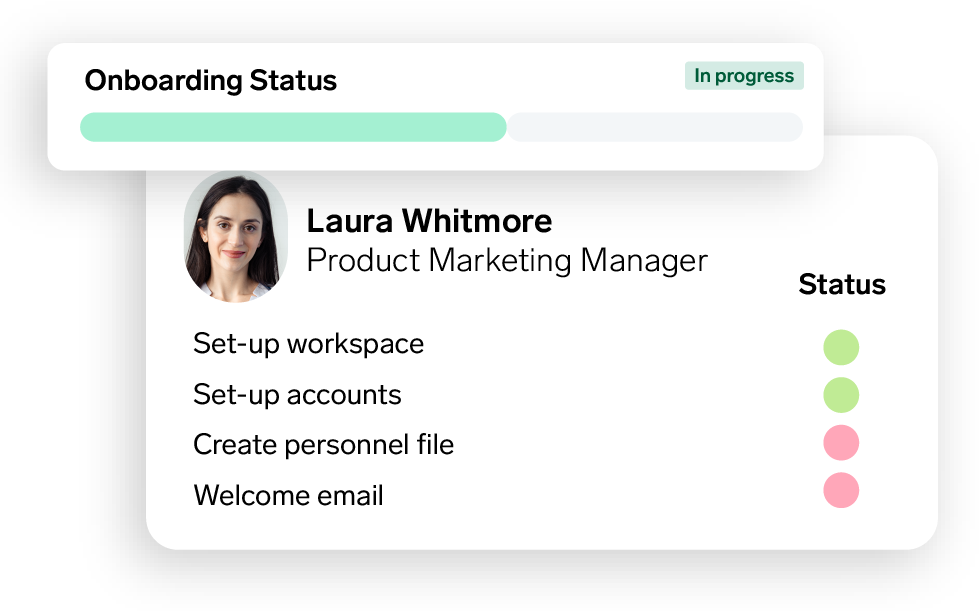
Streamline employee onboarding experiences
Streamline the onboarding experience for new employees with Personio's intuitive software.
Explore our product7 Tips For Your Remote Onboarding

Remote onboarding, and the processes behind it, are fast becoming the new normal. Even in a hybrid setting, you're still likely to have just as many new employees starting in the office as starting remotely. So, what do you do?
In this article, we offer a rundown of the remote onboarding process, answer some critical questions, and offer our own seven tips to make it even easier and more streamlined. Let’s get started!
What Is Remote Onboarding?
Remote onboarding is, as the name suggests, the remote version of employee onboarding. Essentially, it entails all of the steps of the traditional onboarding process, facilitated by different digital tools (for example, video calls or other collaborative tools like shared documents, etc.). The point of remote onboarding is to offer an employee an exciting, integrative experience as part of your organisation, even if they are not in a physical office location.
What Is The Remote Onboarding Process?
We can think of the remote onboarding process is four distinct phases: There is preparing to onboard, welcoming the new employee, educating them on their role, the company, and culture, and then helping them transition over an extended period (with various check-ins, reviews, projects, etc.).
How Do You Onboard Remote Employees?
The same way you would regularly onboard them. The point of remote onboarding is to make it as seamless a process as regular onboarding. This is especially true in a hybrid work context when you want to make sure that every new employee has a similar, exceptional, and efficient experience.
In that sense, onboarding remote employees really comes down to making sure you have an aligned process for both remote and in-office positions. That means having the same tasks, due dates, and the like, stored in one place.
A single source of truth for your entire organisation. Discover Personio today.
How Long Should Remote Onboarding Take?
One of the key differences between remote and in-person onboarding is visibility. Meaning that, for extended periods of time, a new employee may find themselves alone in their role. What this could mean is that you may want to design a remote onboarding process that stretches over a longer period of time.
A typical rule of thumb is that onboarding should take between two weeks and three months, and it all depends on an employee’s role, responsibilities, and seniority. That said, there needs to be a distinction between active onboarding and more passive onboarding.
In remote onboarding, the active portion of onboarding (the intense elements of helping a new employee understand their role) may take two to three weeks, depending on the position. But, passive onboarding, which we will address with some specific measures later in this article, may stretch months (maybe even six months into their tenure).
Onboarding Software: For Seamless New Starts

Give every new employee a flying start with Personio’s automated onboarding software, trusted by 15,000 happy customers across the UK and Europe.
Show me moreWhat Are Some Remote Onboarding Tips?
Now, let’s get into some remote onboarding best practices. Here are some tips that we can share to help the process along, no matter the employee, role, or how they are joining your organisation…
1. Communication, Communication, Communication
Starting a new job remotely can be an anxious time. New employees want to make a great first impression, but they also want to establish a connection — both with their new coworkers and with the organisation, more generally.
In that sense,HR needs to engage closely with new colleagues and communicate openly throughout each step of remote onboarding. Ideally, this will help reassure employees and also help them complete their best work.
One way to do this is with a proper introductory email to new colleagues.
2. Equipment Has To Be Ready
Ideally, all software and tools (including VPN access) should already be installed on new employees’ laptops, because if they work from home they can’t simply drop the IT department to get some help.
Make sure to send outessential hardware, such as:
Laptops
Mice
Keyboards
Headsets (important for online meetings)
Be careful to dispatch these parcels early, as deliveries, so that new employees can be set up for a great start.
3. Remember Training Sessions
Not everybody is used to working remotely. That’s why it is typically a good idea to ask new employees how comfortable they are with meeting and chat tools such as Google Hangouts, Zoom, Slack, etc. – before their first day.
Organise training sessions with all new employees before they start to ensure that they are able to attend all online induction events, or create guidelines to explain the most important functions in the various tools you use.
Click here for an induction checklist you can use today.
4. Personalise Onboarding (Even From A Distance)
Before onboarding begins, or during the early phases, employees should feel engaged. For that reason, members of your team should reach out to new employees to help them feel included.
Imagine: While new hires would normally be welcomed with a friendly smile from their colleagues, all they get now is the glow of the laptop screen. A little personal connection can be a huge help!
Set up virtual coffee breaks, lunches, or after-work drinks to promote communication within teams. You can either arrange these meetings yourself, ask teams to do so, or even have new employees organise meet-and-greet sessions.
Tools such as Wellbeing Warrior can help you support contacts between departments, as they match colleagues randomly for virtual coffee breaks or shared lunches.
5. Set Up Remote Onboarding Buddies
Whether remotely or face-to-face: Personio has an established onboarding buddy program to support new hires as they settle in to set them up for success. New colleagues are teamed up with an existing employee as their "buddy,” who provides them with advice, practical help, and any other superpowers they have to offer.

Especially in a remote setting, a specific buddy can help a new employee feel welcome. They can also introduce them to various processes, understandings, and other aspects of culture that are hard to communicate during traditional onboarding.
It is especially helpful when buddies are from the same level of hierarchy within the organisation. That’s because they are often in pole position to explain what the company stands for, what it’s all about, and what it’s like to work there.
6. Continuous Engagement Helps
As you may have noticed, communication is somewhat of a central theme in remote onboarding. Despite physical distance, there is still a lot happening in the first few days, and new employees have to process a lot of new information. You should help them by always being available to answer questions and by responding quickly.
For example, you can set up meetings for quick updates. These may be as short as 15minutes every other day, but these 15minutes allow you to clarify any unanswered questions and concerns.
To new employees, this communicates to them how much they are appreciated, which in turn leaves a positive impression during the onboarding process.
7. Motivate Through Appreciation
Another challenge of the remote onboarding process is motivating new employees. That’s because motivation can often occur through casual interactions, which are hard to come by at the kitchen table.
Address this potential issue by showing new employees your appreciation throughout the process. Send them a goodie bag with swag before they start, or make sure you check in regularly with them. Team chats and a clearly structured onboarding process are also incredibly helpful.
Ensure that new employees feel positive, and show them that they are on your mind. This promotes enthusiasm and good vibes among new hires and inspires them to give their best right from the start.
How Do You Scale A Remote Onboarding Process?
As your organisation grows and potentially embraces hybrid working practices, you may need to dramatically scale your remote onboarding. In this sense, and HR software can help.
Take Personio for instance: Within our software, you can schedule tasks for new employees and managers alike, give them due dates, and also send them reminders so that nothing is forgotten.
You can also offer easy visualisations of org charts, so new employees understand your corporate structure in a heartbeat, or send our introductory emails to teams so new employees feel welcome to your organisation.
That way, whether ten or one hundred people are starting at the beginning of the month, you have everything firing, everyone in the loop, and all of your new employees feel welcome even when working remotely.
Care to learn more? Click this link to start onboarding with Personio.
Can HR Software Help With Remote Onboarding?
Of course it can. As we outlined above, effective HR software can help remote onboarding by offering a single source of truth for all your onboarding tasks. Not only that, but it also offers a way to automate all these tasks with ease.

About Marina Buller
Marina is Content Marketing Manager at Personio and has dedicated herself entirely to HR and recruiting topics. After completing her master's degree in Lund, Sweden, she gained HR insights while working at XING. She now incorporates this experience into her texts - always following Personio's motto of "simplifying HR work".

